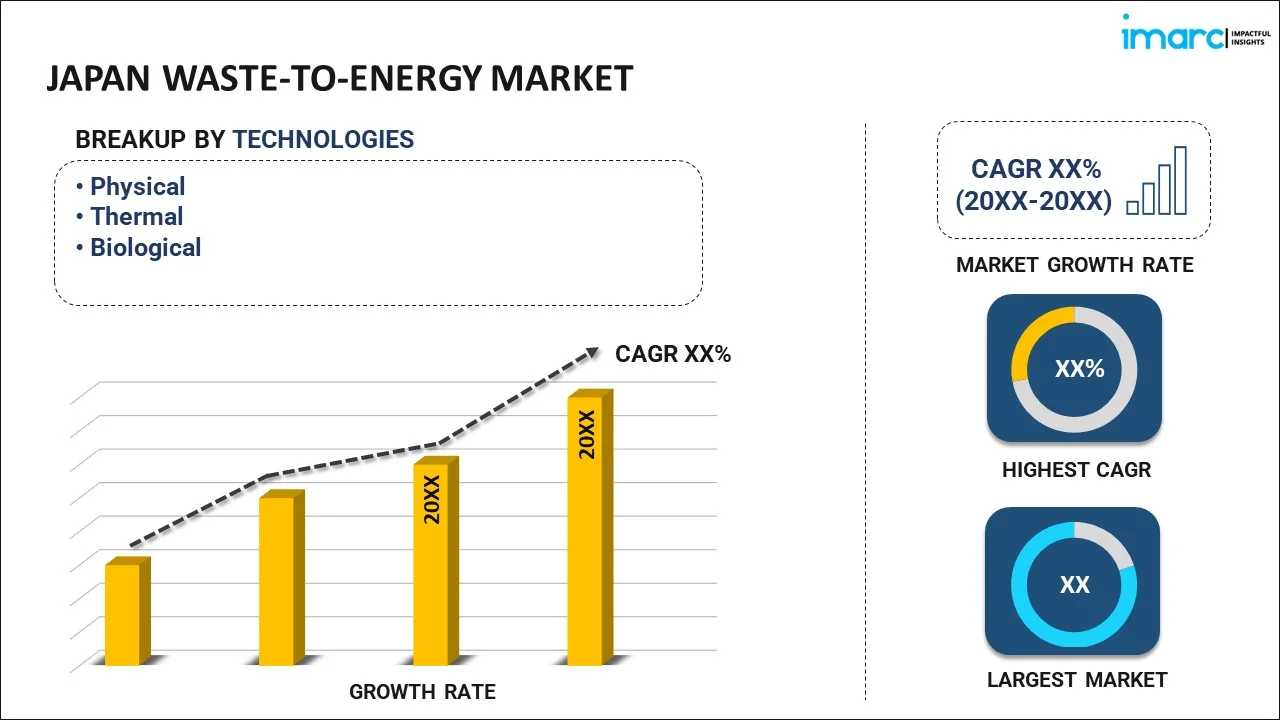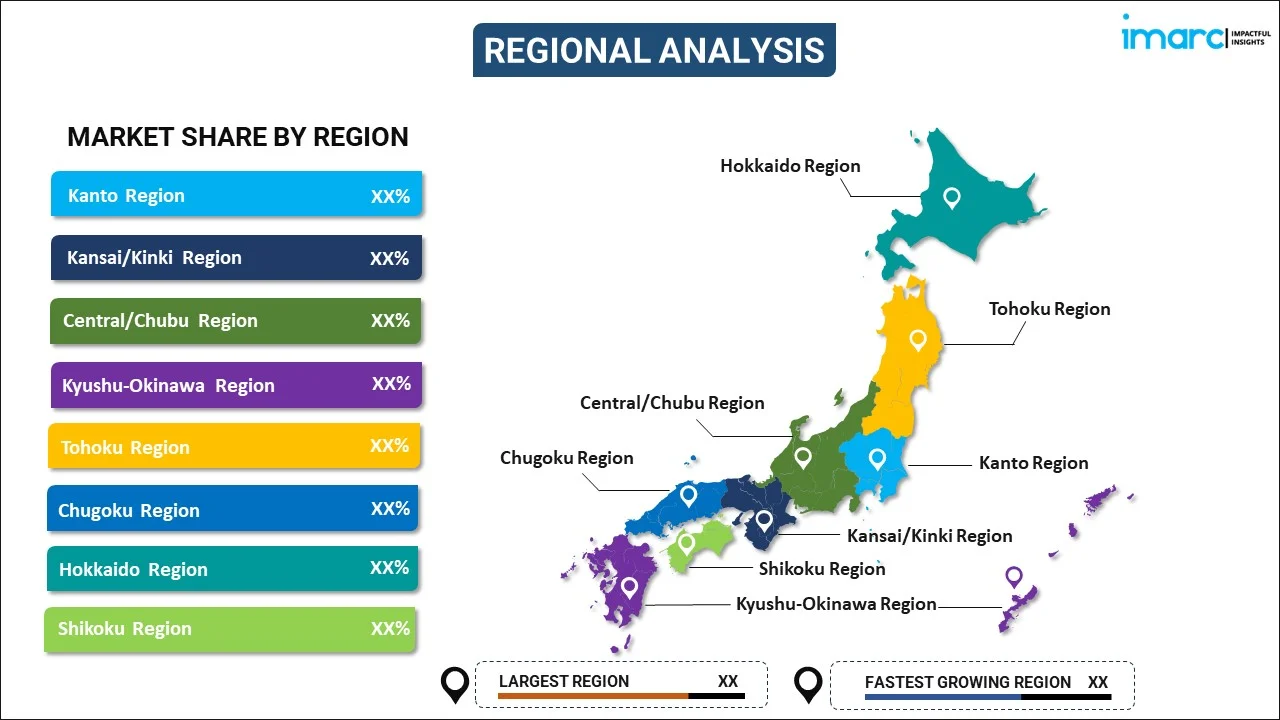
Japan Waste-to-Energy Market Report by Technology (Physical, Thermal, Biological), and Region 2025-2033
Market Overview:
Japan waste-to-energy market size reached 59.2 TWh in 2024. Looking forward, IMARC Group expects the market to reach 81.3 TWh by 2033, exhibiting a growth rate (CAGR) of 3.42% during 2025-2033. The increasing consumer environmental concerns towards landfill waste that leads to climate change are primarily driving the market growth.
|
Report Attribute
|
Key Statistics
|
|---|---|
|
Base Year
|
2024 |
|
Forecast Years
|
2025-2033 |
|
Historical Years
|
2019-2024
|
| Market Size in 2024 | 59.2 TWh |
| Market Forecast in 2033 | 81.3 TWh |
| Market Growth Rate (2025-2033) | 3.42% |
Waste-to-energy (WTE) denotes the method of transforming non-reusable waste substances into beneficial heat, power, or fuel using techniques like combustion, gasification, devolatilization, anaerobic breakdown, and landfill gas capture. In line with this, it utilizes various mechanisms to generate electricity by incinerating untreated municipal waste within a furnace paired with a boiler and generator. Currently, it's viewed as an essential aspect of waste handling, as WTE contributes to climate change mitigation, curtails greenhouse gas emissions, and lessens ecological repercussions and health risks. This method further aids in sidestepping methane from dumps, reclaiming metals for reuse, and counterbalancing emissions from carbon-based electricity creation.
Japan Waste-to-Energy Market Trends:
Japan's waste-to-energy market showcases a progressive blend of innovative solutions addressing the nation's waste management challenges. Given the limited land availability for landfills, combined with Japan's commitment to environmental sustainability, this method has emerged as a pivotal strategy for waste disposal. Additionally, recent trends indicate a growing inclination towards advanced incineration techniques, offering not only waste reduction but also efficient energy production, which is propelling the regional market. Besides this, technologies, such as gasification and advanced thermal treatment, are gaining traction, driven by their ability to handle diverse waste streams and generate cleaner energy. Driving the waste-to-energy market in Japan is a combination of factors. First, the nation's stringent regulations on waste disposal and emissions underscore the urgency to adopt cleaner and efficient waste management techniques. Second, Japan's urbanization and population density mean that waste generation is high, necessitating sophisticated solutions for waste processing. Another significant driver is the growing public and corporate consciousness towards sustainability. Businesses are more proactive in aligning with national sustainability goals, and WTE offers a tangible solution in this direction. Also, the Japanese government's incentives and supportive policies for renewable energy projects have made waste-to-energy projects financially attractive. In conclusion, the Japan waste-to-energy market is in a phase of dynamic growth and innovation, steered by technological advancements and the nation's unwavering commitment to a sustainable future. These factors are projected to bolster the regional market over the forecasted period.
Japan Waste-to-Energy Market Segmentation:
IMARC Group provides an analysis of the key trends in each segment of the market, along with forecasts at the country level for 2025-2033. Our report has categorized the market based on technology.
Technology Insights:

- Physical
- Thermal
- Biological
The report has provided a detailed breakup and analysis of the market based on the technology. This includes physical, thermal, and biological.
Regional Insights:

- Kanto Region
- Kansai/Kinki Region
- Central/ Chubu Region
- Kyushu-Okinawa Region
- Tohoku Region
- Chugoku Region
- Hokkaido Region
- Shikoku Region
The report has also provided a comprehensive analysis of all the major regional markets, which include Kanto Region, Kansai/Kinki Region, Central/ Chubu Region, Kyushu-Okinawa Region, Tohoku Region, Chugoku Region, Hokkaido Region, and Shikoku Region.
Competitive Landscape:
The market research report has also provided a comprehensive analysis of the competitive landscape in the market. Competitive analysis such as market structure, key player positioning, top winning strategies, competitive dashboard, and company evaluation quadrant has been covered in the report. Also, detailed profiles of all major companies have been provided.
Japan Waste-to-Energy Market Report Coverage:
| Report Features | Details |
|---|---|
| Base Year of the Analysis | 2024 |
| Historical Period | 2019-2024 |
| Forecast Period | 2025-2033 |
| Units | TWh |
| Scope of the Report | Exploration of Historical Trends and Market Outlook, Industry Catalysts and Challenges, Segment-Wise Historical and Future Market Assessment:
|
| Technologies Covered | Physical, Thermal, Biological |
| Regions Covered | Kanto Region, Kansai/Kinki Region, Central/ Chubu Region, Kyushu-Okinawa Region, Tohoku Region, Chugoku Region, Hokkaido Region, Shikoku Region |
| Customization Scope | 10% Free Customization |
| Post-Sale Analyst Support | 9-11 Weeks |
| Delivery Format | PDF and Excel through Email (We can also provide the editable version of the report in PPT/Word format on special request) |
Key Questions Answered in This Report:
- How has the Japan waste-to-energy market performed so far and how will it perform in the coming years?
- What has been the impact of COVID-19 on the Japan waste-to-energy market?
- What is the breakup of the Japan waste-to-energy market on the basis of technology?
- What are the various stages in the value chain of the Japan waste-to-energy market?
- What are the key driving factors and challenges in the Japan waste-to-energy?
- What is the structure of the Japan waste-to-energy market and who are the key players?
- What is the degree of competition in the Japan waste-to-energy market?
Key Benefits for Stakeholders:
- IMARC’s industry report offers a comprehensive quantitative analysis of various market segments, historical and current market trends, market forecasts, and dynamics of the Japan waste-to-energy market from 2019-2033.
- The research report provides the latest information on the market drivers, challenges, and opportunities in the Japan waste-to-energy market.
- Porter's five forces analysis assist stakeholders in assessing the impact of new entrants, competitive rivalry, supplier power, buyer power, and the threat of substitution. It helps stakeholders to analyze the level of competition within the Japan waste-to-energy industry and its attractiveness.
- Competitive landscape allows stakeholders to understand their competitive environment and provides an insight into the current positions of key players in the market.
Need more help?
- Speak to our experienced analysts for insights on the current market scenarios.
- Include additional segments and countries to customize the report as per your requirement.
- Gain an unparalleled competitive advantage in your domain by understanding how to utilize the report and positively impacting your operations and revenue.
- For further assistance, please connect with our analysts.

 Inquire Before Buying
Inquire Before Buying
 Speak to an Analyst
Speak to an Analyst
 Request Brochure
Request Brochure
 Request Customization
Request Customization



.webp)




.webp)












